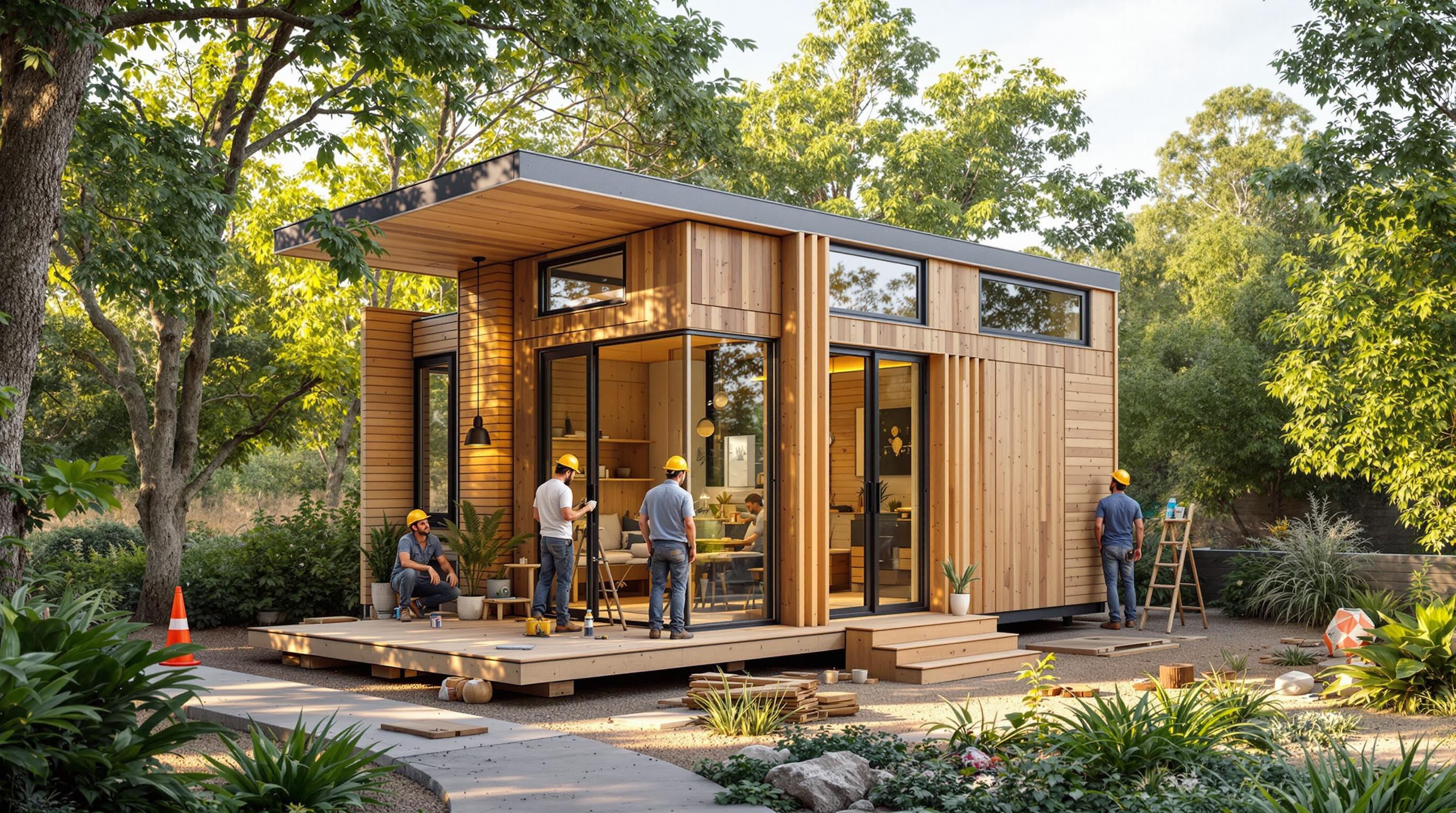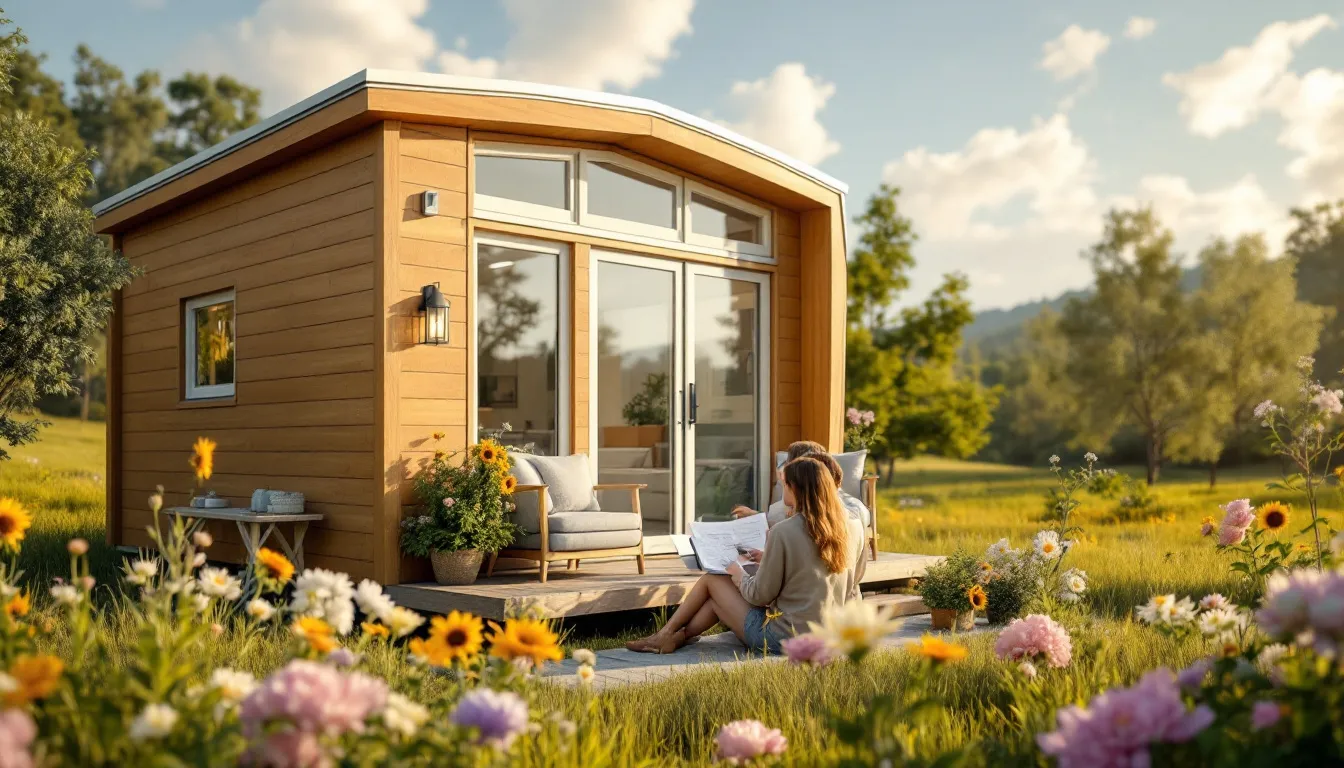Ventilation is crucial for tiny houses to maintain air quality, control moisture, and ensure a healthy living space. Without it, problems like mold, respiratory issues, and structural damage can arise. Here’s a quick overview of what you need to know:
- Why It Matters: Tiny houses are airtight, so pollutants and moisture build up quickly.
- Key Solutions: Use Energy Recovery Ventilation (ERV) systems, exhaust fans, and dehumidifiers. Add strategically placed windows for natural airflow.
- Maintenance Tips: Clean filters regularly, inspect vents, and monitor air quality with CO2 monitors and hygrometers.
- Safety Musts: Install carbon monoxide detectors and smoke alarms.
Proper planning and maintenance of ventilation systems ensure a comfortable and safe tiny home. Dive in for actionable tips and detailed solutions.
Heat and Energy Recovery Ventilators: Going Ductless
The Importance of Proper Airflow in Tiny Homes
Good airflow in tiny homes is crucial for keeping the structure intact and ensuring the health of those living inside. In such small spaces, airflow plays a key role in managing humidity, maintaining air quality, and keeping energy use in check.
Problems Caused by Poor Ventilation
Without proper ventilation, tiny homes can face issues affecting both the building and its residents:
| Problem Area | Impact | Prevention Method |
|---|---|---|
| Health and Air Quality | Build-up of VOCs and CO2, respiratory issues | Install mechanical ventilation and air filters |
| Structural Integrity | Condensation leading to wood damage | Use vapor barriers and proper insulation |
| Energy Efficiency | Higher heating and cooling costs | Add energy recovery ventilation (ERV) systems |
Moisture from daily activities like cooking and showering builds up quickly in such compact spaces. Tackling these problems requires addressing the unique design limitations of tiny homes.
Challenges of Ventilating Small Spaces
Tiny homes present specific ventilation challenges, such as:
- Tight, compact designs: These limit where ventilation systems can be placed and reduce natural airflow.
- Activity concentration: Everyday tasks in smaller spaces create more noticeable impacts on air quality and moisture levels.
To manage moisture, experts suggest using dry heat sources like electric heaters or small wood stoves. Adding multiple windows, especially in areas like kitchens and bathrooms, can promote natural airflow.
Small-scale ventilation systems are another practical option, as they don't need large ductwork [3]. During construction, weatherproofing and vapor barriers can help keep moisture out. When paired with mechanical ventilation, these measures protect the home’s structure and maintain healthy air quality.
Now that we’ve covered the challenges, let’s dive into actionable ways to improve airflow in tiny homes.
Ways to Improve Ventilation in Tiny Houses
Tiny houses come with unique ventilation challenges, but there are practical ways to improve airflow and maintain good air quality.
Using Natural Ventilation
Natural ventilation is a key part of managing airflow in a tiny house. By placing windows strategically, you can create cross-ventilation patterns that keep fresh air circulating. Position windows at different heights to use the stack effect - where warm air rises and exits while cooler air flows in below. You can also add features like operable skylights, solar-powered vents, or window awnings to boost airflow.
| Feature | Purpose |
|---|---|
| Operable Skylights | Releases warm air |
| Solar-powered Vents | Encourages passive airflow |
| Window Awnings | Guides air movement |
Adding Mechanical Ventilation Systems
Natural airflow is helpful, but mechanical systems ensure steady ventilation no matter the weather. Energy Recovery Ventilation (ERV) systems are a popular choice for tiny homes. They exchange stale indoor air with fresh outdoor air while maintaining comfortable indoor temperatures [2].
Exhaust fans are another must-have, especially in kitchens and bathrooms. These compact, wall-mounted systems are perfect for small spaces and don’t require complex ductwork [3].
Reducing Moisture and Preventing Condensation
Managing moisture is essential for protecting your tiny house from damage and keeping the air healthy. Properly installed vapor barriers can help reduce moisture buildup significantly [5].
| Area | Solution | Maintenance |
|---|---|---|
| Kitchen | Range hood with exterior vent | Clean monthly |
| Bathroom | Automatic bathroom fan | Inspect quarterly |
| Living Space | Dehumidifier | Empty regularly |
Dehumidifiers are especially effective when placed near moisture-heavy areas like the kitchen or bathroom [4]. Regular upkeep of these systems is key to keeping them running smoothly and extending their lifespan.
sbb-itb-2ef3f3a
How to Maintain Ventilation Systems
After setting up natural and mechanical ventilation, keeping these systems in good shape is key to ensuring they work efficiently over time. Routine maintenance helps prevent moisture problems and keeps your equipment running smoothly.
Cleaning and Replacing Filters
Taking care of filters is crucial for keeping your ventilation system effective. Here's a handy schedule to follow:
| Component | Cleaning Schedule | Replacement Interval |
|---|---|---|
| Main System Filters | Every 3-6 months | Every 2-3 years |
| Kitchen Range Hood | Monthly | When damaged |
| ERV System | Every 4 months | Every 2 years |
When cleaning exhaust fans and vents, use a soft brush or a vacuum to clear out dust and debris [1]. Pay special attention to kitchen and bathroom vents, as they tend to gather grease and moisture. For ERV systems, which are popular in tiny houses, regular cleaning and timely filter replacement are necessary to maintain proper air exchange and energy efficiency.
Safety Tips for Ventilation Systems
Safety plays a big role in maintaining good air quality. Install carbon monoxide detectors near sleeping areas, smoke alarms in cooking spaces, and keep a fire extinguisher within reach. Test alarms every month and replace their batteries once a year.
Make it a habit to inspect your ventilation systems regularly to avoid blockages and to ensure steady airflow [3]. This includes checking outdoor vents, screens, and other components for any debris or damage that might interfere with their operation.
Resources for Tiny House Ventilation
Getting the right information and support is crucial for setting up proper ventilation in a tiny house. The U.S. Department of Energy offers detailed guidelines tailored to tiny house ventilation, ensuring systems align with building standards and energy efficiency recommendations.
You can find educational resources through several platforms:
| Platform | Resource Type | Cost Range |
|---|---|---|
| Udemy | Video courses on tiny house systems | $20-100 |
| Coursera | Technical workshops | $40-200 |
| Local Builder Workshops | In-person training | $200-500 |
For professional help with installation and maintenance, platforms like Thumbtack and Angie's List can connect you with local experts. Costs range from $120 for basic systems to $8,500 for more advanced setups [2].
Tiny Houses For Sale, Rent, and More

Tiny Houses For Sale, Rent, and More is a go-to resource for the tiny house community. This platform connects users with local professionals, building techniques, and guides for ventilation installation. It also features a directory of builders specializing in tiny house ventilation systems, along with detailed implementation strategies.
Their resources section provides insights into ventilation-related building codes and installation requirements, helping owners navigate the technical aspects of tiny homes. The community forum is a great place for experienced tiny house owners to share knowledge about different ventilation solutions.
Organizations like Healthy Home Ventilation are actively researching and developing new solutions for tiny house ventilation [3]. For maintenance tips, established tiny house blogs often share practical advice, such as how to clean exhaust fans to reduce the risk of mold [1].
Summary of Tiny House Ventilation Tips
Tiny houses come with unique challenges, especially when it comes to ventilation. Limited space makes managing airflow even more important to protect both the structure and the health of those living inside. Here's how you can keep your tiny home well-ventilated:
Choosing the Right Systems
Strategically placed ventilation units work best in tiny homes. Systems like ERVs (Energy Recovery Ventilators) not only improve indoor air quality but also help manage humidity and save on heating and cooling by capturing heat during air exchanges [3].
Managing Moisture
To avoid condensation issues, use tools like dehumidifiers, dry heat sources, and double-paned windows [5].
| Area | Suggested Solution | Maintenance Frequency |
|---|---|---|
| Kitchen | Exhaust Fan + ERV | Clean every 6 months |
| Bathroom | Dehumidifier + Mechanical Vent | Check filters monthly |
| Living Space | Double-paned Windows + Air Vents | Inspect quarterly |
Routine Maintenance
Keep your system running smoothly by cleaning exhaust fans and vents every 6 months, replacing ERV filters every 2-3 years, and inspecting vents regularly [1].
Get Professional Help
HVAC experts can ensure your system is the right size, properly installed, and compliant with building codes. Professional installation also boosts efficiency [2].
Energy-Saving Tips
Pair mechanical ventilation with well-placed windows for cross-ventilation when weather allows [3]. This approach keeps your home comfortable while conserving energy.
FAQs
What is the best ventilation for a tiny house?
ERV systems are a great choice for tiny homes. These compact units exchange stale air for fresh air while conserving energy. They typically cost between $500 and $1,700 [2]. ERV systems help maintain good air quality and energy efficiency, making them a solid option for tiny house ventilation.
How can I effectively manage moisture in my tiny house?
To keep moisture under control, use extractor fans, dehumidifiers, and encourage natural airflow. Pair mechanical ventilation with well-placed windows and vents for the best results [1][5].
What maintenance schedule should I follow?
- Clean ERV filters monthly.
- Deep clean exhaust fans every six months.
- Replace filters every 2-3 years.
Regular upkeep ensures your system works efficiently and lasts longer.
Are there specific safety requirements for tiny house ventilation?
Yes, safety is critical. Have your system professionally installed to meet building codes and minimize risks. Routine maintenance, like cleaning filters, helps prevent issues such as fire hazards from clogged components [2].
How do I know if my ventilation system is working properly?
Watch for these signs:
- Consistent air exchange without strong drafts
- Less condensation on windows
- Lower humidity inside
- No musty smells
- Cooking odors clear quickly
For more tips and resources on tiny house ventilation, check out Tiny Houses For Sale, Rent, and More at https://tinyhousesearch.com. It’s a helpful hub for tiny house enthusiasts [context].



